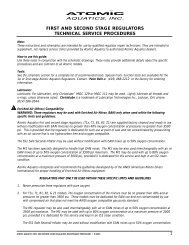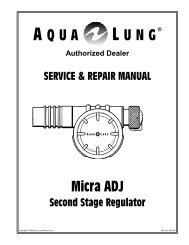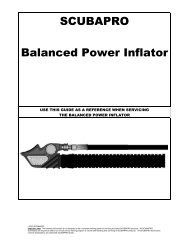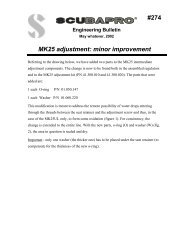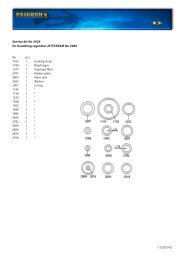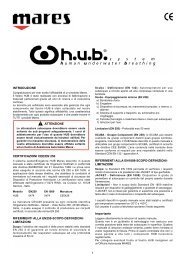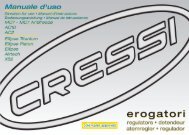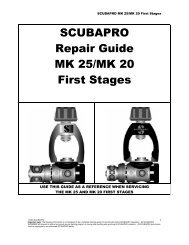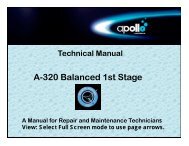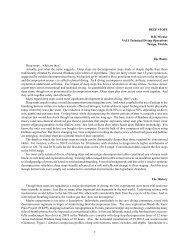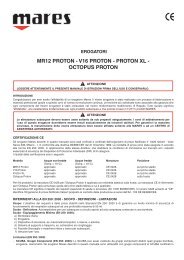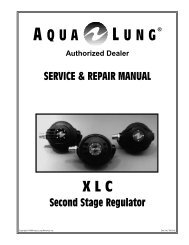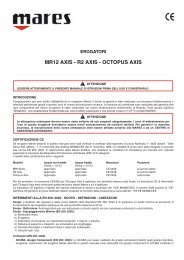Glacia 2nd-Stage Service Manual.pdf1292 KBytes - Frogkick.dk
Glacia 2nd-Stage Service Manual.pdf1292 KBytes - Frogkick.dk
Glacia 2nd-Stage Service Manual.pdf1292 KBytes - Frogkick.dk
Create successful ePaper yourself
Turn your PDF publications into a flip-book with our unique Google optimized e-Paper software.
4 <strong>Glacia</strong> Second <strong>Stage</strong> <strong>Service</strong> & Repair <strong>Manual</strong>4. While holding the second stage secure, firmly grasp the collar of the front cover (3) which is seatedover the ribbed adjustment port of the box bottom, opposite of the inlet side. Stretch the collar overthe adjustment port (see Fig. 3), and lift the front cover off the box bottom until the opposite collar canbe removed from the inlet fitting.Fig. 3 - Removing Front Cover5. If it is necessary, press out the stem of the purge button (2) from inside the front cover. Closely examinethe front cover to check for any tears, distortion, deterioration, or other signs of damage. Replaceit if found, or set it aside if it is in reusable condition.6. Lift out the sealing ring (4) and diaphragm (5) from the box bottom. Separate these two parts and closelyinspect the diaphragm to ensure that it is perfectly round and free of any tears, deterioration, or otherdamage. If deterioration or damage is found, discard the diaphragm and do not attempt to reuse.7. While depressing the lever, unscrew the adjustable crown (32) about 6 or 7 full turns (see Fig. 4).unscrew 6 to 7 full turnsFig. 4 – Loosen Adjustable Crowndepress lever8. Apply an 8mm wrench to the connecting nut (11) and another 8mm wrench to the sheath (13). SeeFig. 4. Turn the connecting nut counterclockwise to initially loosen it from the sheath. Once loosened,use your fingers to fully unscrew the sheath from the connecting nut.Fig. 5 – Loosen ConnectingNut and Sheath© 2000 Aqua Lung America, Inc.
<strong>Glacia</strong> Second <strong>Stage</strong> <strong>Service</strong> & Repair <strong>Manual</strong> 59. Using a 19mm (¾") wrench, turn the inlet fitting (31) counterclockwise and remove it from the secondstage.Carefully insert the pin of the extraction tool (P/N 109436) into the opposite end of the inletfitting and through the center of the crown. Gently press the crown out onto a padded surface (seeFig. 6). Remove and discard the inlet fitting o-ring (30) and crown o-ring (33).Fig. 6 – Remove Adjustable Crown10. Closely examine the crown with the use of a magnifier, checking for any scoring, nicks, or otherdamage to the polished sealing surface. If damage is found, discard the crown, and do not attempt toreuse. If it is in reusable condition, set it aside on a soft surface to prevent damage to the sealing edge.11. Remove the ribbed plug (16) by turning it counterclockwise with a 4mm hex key. Remove the o-ring(17) from the plug and discard.12. While keeping the lever assembly pressed against the sidewall, unscrew the insert (18) by turning itcounterclockwise with a 19mm ( ¾") wrench. The insert is o-ring sealed, therefore, it will need to bepulled out of the second-stage once the threads are disengaged. Remove and discard the o-ring (19).13. Gently lift out the lever assembly and valve body assembly from the second stage.14. Remove the locknut (20) located inside the lever retainer by turning it counterclockwise with a ¼"nutdriver. Separate the lever assembly parts, including the connecting rod (12), sheath (13), lever (14),lever retainer (15), washer (21) and locknut. Closely inspect the shape and condition of the lever toensure it is not bent, corroded, or otherwise damaged. If any signs of damage or corrosion are found,discard the lever and do not reuse.15. Remove the connecting nut (11) from the poppet stem by holding the head of the poppet (8) with an8mm wrench and turning the connecting nut counterclockwise with another 8mm wrench (see Fig 7).HOLDFig. 7 – Loosen Connecting Nut and Sheath© 2000 Aqua Lung America, Inc.
6 <strong>Glacia</strong> Second <strong>Stage</strong> <strong>Service</strong> & Repair <strong>Manual</strong>16. Separate the spring (9) from the poppet. Using the brass o-ring tool or a safety pin, pierce the center oflow-pressure seat (7) and remove it from the poppet.17. With the front of the second-stage housing facing you and the mouthpiece opening flat against thework surface, use a small screwdriver to rotate the vane c-clip so the open end is facing you. Whileholding the box bottom secure, place the tines of the Micra Pre-adjustment Tool (P/N 100168) squarelyagainst the ends of the circlip (26) as shown in Fig. 8. Gently press the circlip straight off the vaneadjustment switch (27), and set it aside.Fig. 8 – V.A.S. Circlip Removal18. Pull the vane adjustment switch straight up and out of the outlet boss of the box bottom. Remove anddiscard the o-ring (28), and set the switch aside.This concludes the disassembly of the <strong>Glacia</strong> second stage. Refer directly to Procedure A andTable A, titled "Cleaning & Lubrication", before proceeding to the Reassembly Procedures.© 2000 Aqua Lung America, Inc.
<strong>Glacia</strong> Second <strong>Stage</strong> <strong>Service</strong> & Repair <strong>Manual</strong> 7REASSEMBLY PROCEDURESNOTE: Before starting reassembly, it is important to inspect all parts, both new and those that arebeing reused, to ensure that every part and component is perfectly clean and free of any dust,corrosion, or blemishes. Check all o-rings to ensure they are clean and supple before dressing witheither Christo-Lube ® or Dow 111 silicone grease.WARNING: Use only genuine Aqua Lung parts, subassemblies, and components whenever assemblingany Aqua Lung product. DO NOT attempt to substitute an Aqua Lung part with anothermanufacturer’s, regardless of any similarity in shape, size, or appearance. Doing so may render theproduct unsafe, and could result in serious injury or death.1. Install the o-ring (28) onto the vane adjustment switch (27).2. Mate the stem of the vane switch into its respective hole in the box bottom (29), above the outlet boss,and align the mating pin above the positioning guide (see Fig. 9). When the switch is correctly aligned,press it down and into place so that it is properly seated inside the box bottom.Fig. 9 – V.A.S. Alignment3. Press the circlip (26) into the recessed ledge in the forks of the Circlip/ Retaining Ring Tool(P/N 107846), with its flat side facing down and the open end facing out of the tool (see Fig. 10). Thespring tension of the tool will hold the circlip in place while it is being positioned inside the boxbottom.Flat side faces downFig. 10 – Loading Circlip Tool© 2000 Aqua Lung America, Inc.
8 <strong>Glacia</strong> Second <strong>Stage</strong> <strong>Service</strong> & Repair <strong>Manual</strong>4. While holding the vane switch in place, set the box bottom on a flat surface with the open side facingdown and the switch at 12 o’clock. Guide the tool holding the circlip into the outlet boss, with the topsurface of the tool held flush against the ceiling, directly behind the vane. Press the circlip evenly ontothe groove of the vane stem until it snaps audibly into place (see Fig. 11). Remove the tool and examineclosely to ensure the circlip is seated completely inside the groove. Remove and reinstall thecirclip if necessary.Fig. 11 – V.A.S. Circlip InstallationCAUTION: It is important to ensure that the vane adjustment switch, o-ring, and circlip are correctlyinstalled in order to maintain the watertight integrity of the box bottom assembly. Improperinstallation may result in flooding of the second stage.5. Install the exhaust valve diaphragm (22) into the box bottom by gently pulling the stem through thehole in the center of the support spokes, until the barb has passed through and is securely seatedinside the box bottom. Carefully snip off the excess material of the stem.6. Install the exhaust tee (6) onto the box bottom by fitting it over one upper corner of the seating flangeand then stretching it over the other. Firmly press the lower portion of the tee onto the flange until it iscompletely seated.CAUTION: Do not use a tool to install the exhaust tee. Doing so may cause serious damage to theseating flange, requiring replacement of the box bottom.7. Install a new crown o-ring (33) and inlet fitting o-ring (30). Carefully insert the threaded end of thecrown into the hose connection end of the inlet fitting (see Fig. 12a). Gently press it in further withthe blunt end of the extraction tool (P/N 1094-36) until it stops (see Fig. 12b).a.b.Fig. 12 – Crown Installation© 2000 Aqua Lung America, Inc.
<strong>Glacia</strong> Second <strong>Stage</strong> <strong>Service</strong> & Repair <strong>Manual</strong> 98. Apply a medium blade screwdriver to the slotted head of the adjustable crown (32), and turn the crownclockwise to engage the threads. Continue turning the crown clockwise until it stops. Then turn thecrown out counterclockwise exactly four (4) complete turns to arrive at its correct preliminary setting.9. Insert the threaded end of the connecting rod (12) into the threaded side of the sheath (13) as shown inFig. 13a. Screw the connecting nut (11) into the sheath until fingertip tight (see Fig. 13b). Do nottighten the connecting nut, as it will be removed later in the reassembly procedure.a.b.Fig. 13 – Sheath Assembly10. a. Hold the lever retainer (15) with the rounded side facing upward. With the tip of the lever pointingdownward, insert the "feet" of the lever (14) into the lever retainer (see Fig. 14a). Lift up on the end ofthe lever so it is pointing upward.b. While keeping the lever in the up position, insert the threaded end of the connecting rod through thesquared hole in the front of the lever retainer (see Fig, 14b).c. While keeping the sheath pressed against the lever retainer, drop the washer (21) over the threadedend of the connecting rod (see Fig. 14c). Place a new locknut (20), rounded side first, into the nutdriver.Screw the locknut onto the connecting rod until it is flush with the end of the connecting rod(see Fig. 14d). Starting from the flush position, screw the locknut an addition two full turns (see Fig14e).a.b.c. d.Flushe.Fig. 14 – Lever Assembly2 fullturns pastflush© 2000 Aqua Lung America, Inc.
10 <strong>Glacia</strong> Second <strong>Stage</strong> <strong>Service</strong> & Repair <strong>Manual</strong>11. Unscrew the connecting nut (11) from the sheath (13)12. Examine a new low pressure seat (7). One side is flat and one side has a molding dimple. Press the lowpressure seat into the end of the poppet (8) such that the flat side of the seat is facing outward and it isflush with the poppet (see Fig. 15).Fig. 15 – LP Seat Installed in Poppet13. Place the spring (9) over the shaft of the poppet. Insert the poppet, threaded end first, into the threadedside of the valve body (see Fig. 16a). Press the valve body against the work surface to expose thethreaded end of the poppet. Thread the connecting nut (11) onto the poppet (see Fig. 16b).a.b.Fig. 16 – Installing Poppet into Valve Body14. Attach an 8mm socket to an inch-pound torque wrench. While holding the head of the poppet with an8mm wrench, tight the connecting nut to 10 inch-pounds (see Fig. 17).Fig. 17 – Torque Nut to Poppet© 2000 Aqua Lung America, Inc.
<strong>Glacia</strong> Second <strong>Stage</strong> <strong>Service</strong> & Repair <strong>Manual</strong> 1115. With the front of the second-stage body facing you, place the valve assembly, rounded side facingupward, into the second-stage and insert it into the hole on the left. The valve body is keyed so it canonly be inserted one way (see Fig. 18).Fig. 18 – Installing Valve Body16. Hold the lever assembly with the lever facing you and the sheath pointing to the left. Insert the leverassembly into the hole on the right (see Fig. 19).Fig. 19 – Installing Lever Assembly17. Place a new o-ring (19) onto the insert (18). While keeping the lever assembly pressed against thesidewall, screw the insert into the lever retainer until fingertight. Attach a 19mm (³⁄₄") crows-footadapter to a torque wrench and tighten the insert to 85±3 inch-pounds (see Fig. 20).Fig. 20 – Installing Retainer© 2000 Aqua Lung America, Inc.
12 <strong>Glacia</strong> Second <strong>Stage</strong> <strong>Service</strong> & Repair <strong>Manual</strong>18. Using your fingers, thread the sheath onto the connecting nut until fingertight. While holding thesheath with a 8mm wrench, tighten the connecting nut with another 8mm wrench (see Fig. 21).Fig. 21 – Tightening Connecting Nut toSheath19. While keeping the valve body pressed against the sidewall, thread the inlet fitting (31) into the valvebody (see Fig. 22). Attach a 19mm (³⁄₄") crows-foot adapter to a torque wrench and tighten the inletfitting to 85±3 inch-pounds.Press against valve bodyFig. 22 – Install Inlet Fitting20. Install two new o-rings (34 & 36) onto the IP hose.© 2000 Aqua Lung America, Inc.
14 <strong>Glacia</strong> Second <strong>Stage</strong> <strong>Service</strong> & Repair <strong>Manual</strong>FINAL ASSEMBLY & TESTING1. Install a new o-ring (17) onto the ribbed plug (16). Thread the plug into the insert until fingertight. Attacha 4mm hex key to a torque wrench and tighten the plug to 20 inch-pounds (see Fig. 25.)Fig. 25 – Tourque Plug to xx Inch-Pounds2. Insert the sealing ring (4) into the diaphragm (5) as shown in Fig. 26a. Insert the diaphragm assemblyinto the second-stage as shown in 26b. Make sure the diaphragm is seat against the box bottom.a.b.Fig. 26 – Install Diaphragm Assembly3. With the purge button decal properly aligned, slip the left collar of the purge cover over the inlet fitting(see Fig. 27a). Stretch the right collar over the adjustment port, work the top and bottom of the purgecover onto the second-stage, making sure the purge cover is properly seated around the perimeter (seeFig. 27b).a.b.Make sure cover is seatedproperly at the top and bottomFig. 27 – Install Front Cover© 2000 Aqua Lung America, Inc.
<strong>Glacia</strong> Second <strong>Stage</strong> <strong>Service</strong> & Repair <strong>Manual</strong> 154. Attach an ¹¹⁄₁₆" crows-foot to a torque wrench. Thread the female end of the hose onto the inlet fitting.While holding the inlet fitting with a 19mm (³⁄₄") wrench, tighten the hose to 40±2 inch-pounds.NOTE: Before performing the following procedure, refer to Table 5, titled "Test Bench Specifications -<strong>Glacia</strong> <strong>2nd</strong> <strong>Stage</strong>."NOTE: If an accurately calibrated airflow test bench is not available, proceed to the Subjective TuningProcedures provided on the following page.SECOND STAGE OPENING EFFORT TEST1. Connect the first stage regulator to a calibrated test bench and pressurize the system to 3000 (±100)psi. Slowly open the flowmeter control knob (start vacuum) while watching both the magnahelic gaugeand the intermediate pressure gauge.2. When the intermediate pressure begins to drop, indicating the second-stage valve is open, themagnahelic gauge should indicate an opening effort of +1.0" to +1.6" of H 2 O. If the opening effortmeets this specification, you may skip step 3 below.3. If the opening effort does not meet the specifications in step 2, you must readjust the crown (32). Ingeneral, turning the crown counterclockwise (outward) will decrease opening effort and raise the leverheight; turning the crown clockwise (inward) will increase opening effort and lower the lever height.Therefore, each time the crown is turned in either direction, the lever height must be readjusted so itremains flush with the rim of the box bottom. The lever height is adjusted by tightening or looseningthe locknut (20). To readjust the regulator, you will need to remove the hose (35), front cover (3),diaphragm (5) and ribbed plug (16). Refer to Disassembly Procedures, steps 1, 4, 6, 11, respectively.a. To decrease opening effort: Turn the crown ¹⁄₄ turn counterclockwise. Attach the hose to the second-stageand pressurize the system. Turn the locknut counterclockwise until the lever is flush with therim of the box bottom. Reassemble the second-stage an retest the opening effort. Repeat this step untilthe opening effort meets specification.b. To increase opening effort: Turn the crown ¹⁄₄ turn clockwise. Attach the hose to the second-stageand pressurize the system. Turn the locknut clockwise until the lever is flush with the rim of the boxbottom. Reassemble the second-stage an retest the opening effort. Repeat this step until the openingeffort meets specification.SECOND STAGE AIR FLOW TEST1. Slowly turn the flowmeter control knob until the flow reaches a minimum of 15 SCFM (425 liters perminute). The reading on the Magnahelic gauge (inhalation / exhalation effort gauge) should indicateno more than +6.O” H 2 O. If the reading exceeds +6.0" H 2 O, refer to refer to "Table 1 - Troubleshooting"for corrective actions.SECOND STAGE PURGE FLOW TEST1. Turn off the flowmeter control knob. Next, while the second stage is still mounted on the mouthpieceadapter, watch the flowmeter gauge and depress the purge button until the second stage valve is completelyopen. The flowmeter gauge must indicate a minimum of +5.0 SCFM (142 Liters per minute.). Ifthe purge flow is less than +5.0 SCFM, refer to "Table 1 - Troubleshooting."2. When purge flow is correct, remove the second-stage from the mouthpiece adapter on the flow testbench. Shut the valve of the test bench, and purge the second stage to depressurize the system. Removethe regulator.© 2000 Aqua Lung America, Inc.
16 <strong>Glacia</strong> Second <strong>Stage</strong> <strong>Service</strong> & Repair <strong>Manual</strong>EXTERNAL LEAK TEST1. After disconnecting the regulator from the flow bench, connect it to a scuba cylinder filled to approximately3,000 psi. Open the cylinder valve to repressurize the regulator, and submerge the entiresystem in a test tank of clean water.2. Observe any bubbles arising from the submerged regulator over a one minute period. The recommendedtime is necessary due to slower bubble formation that occurs in smaller leaks. Bubbles indicatea leak, which requires that the system must be disassembled at the source to check sealing surfaces,assembly sequence and component positioning in order to correct the problem(s).NOTE: Extremely small leaks may be better detected by applying a soap solution or Snoop to theleak area. Bubble streams will indicate the source of the leak. Before disassembling to correct anyleaks, rinse the entire regulator thoroughly with fresh water and blow out all residual moisture withfiltered, low-pressure (50 psi) air. Disassemble and remedy the problem, referring to "Table 1 -Troubleshooting."SUBJECTIVE BREATHING TEST1. Depress the purge cover fully to ensure that an adequate volume of air needed to clear the second stageflows through the mouthpiece. Then, inhale slowly but deeply from the mouthpiece. A properly servicedand adjusted regulator should deliver air upon deep inhalation without excessive inhalationeffort, freeflow, or “fluttering” of the second-stage diaphragm. When exhaling, there should be nofluttering or sticking of the exhalation valve. If any of these problems occur, refer to Table 1 -Troubleshooting.This concludes annual service procedures for the <strong>Glacia</strong> Second <strong>Stage</strong> Regulator.© 2000 Aqua Lung America, Inc.
<strong>Glacia</strong> Second <strong>Stage</strong> <strong>Service</strong> & Repair <strong>Manual</strong> 17Table 1Troubleshooting Guide – <strong>Glacia</strong> Second <strong>Stage</strong>SYMPTOM POSSIBLE CAUSE TREATMENTLeakage or freeflow from 1. High first-stage intermediate pressure. 1. Refer to first-stage Troubleshootsecondstage (should be 130-135 psi) ing Guide.2. LP seat (7) damaged or worn. 2. Replace LP seat.3. Crown (32) and/or locknut (20) adjusted 3. Reset crown and locknut toincorrectly, lever set too high.preliminary settings, and repeatAdjustment Procedures.4. Lever bent 4. Replace lever5. Crown(32) sealing surface damaged. 4. Replace crown.6. Poppet spring(9) damaged. 5. Replace poppet spring.Low purge or excessive work 1. Low intermediate pressure. 1. Refer to first-stage Troubleshootofbreathing (full cylinder) (should be 130-135 psi) ing Guide.2. Crown (32) and/or locknut (20) adjusted 2. Reset crown and locknut toincorrectly, lever set too low.preliminary settings, and repeatAdjustment Procedures.3. Intermediate pressure hose(35) 3. Clean or replace hose.clogged or obstructed.4. Lever bent 4. Replace leverWater entering second-stage 1. Hole in mouthpiece (24). 1. Replace mouthpiece.2. Demand diaphragm (5) damaged. 2. Replace demand diaphragm.3. Exhaust diaphragm (22) damaged. 3. Replace exhaust diaphragm(s).4. Vane Adjustment Switch o-ring (29) 4. Disassemble and replace o-ring.dirty, damaged, or worn.5. Diaphragm improperly seated 5. Remove front cover (3) and propbetweenbox bottom (29) anderly reassemble sealing ring withsealing ring (4).diaphragm . (Check for distortion.)6. Box bottom damaged. 6. Disassemble and replace box(Check exhaust valve sealing surface.) bottom.7. Inlet o-ring (30) damaged. 7. Disassemble and replace o-ring.8. Plug o-ring (27) worn or damaged. 8. Disassemble and replace o-ring.CAUTION: Recommended treatments which require disassembly of the regulatormust be performed during a complete overhaul, according to the prescribed proceduresfor scheduled, annual service. Do not attempt to perform partial service.NOTE: This is a partial list of possible problems and recommended treatments. Formore information, refer to the second-stage troubleshooting guide, or contact theRepair Department for assistance with problems not described here.© 2000 Aqua Lung America, Inc.
18 <strong>Glacia</strong> Second <strong>Stage</strong> <strong>Service</strong> & Repair <strong>Manual</strong>Table 2 - Recommended Tool ListPART NO. DESCRIPTION APPLICATION1116-10 I.P. test gauge Intermediate pressure testingN/A 0-120 inch-lbs torque wrench Inlet & hose fittings installation944022 o-ring tools O-ring removal & installationN/A Magnifier w/ illumination Sealing surface inspectionN/A Ultrasonic cleaner Brass & stainless steel parts cleaningN/A Medium blade screwdriver Crown removal/ installationN/A 19mm (³⁄₄") wrench & crows- foot Hex nut removal/ installationN/A ¹¹⁄₁₆" wrench & crows- foot IP hose fittingN/A 8mm wrench (x2) Lever/Poppet assemblyN/A ¹⁄₄" nut driver Valve disassembly/ assembly/ adjustmentN/A Wire cutters Mouthpiece clamp removalN/A 4mm hex key & torque adapter Ribbed plug removal/installation107846 Circlip & Retaining Ring Tool C-clip installation100168 Micra Pre-Adjustment Tool C-clip removal109436 Seat extraction/installation tool Crown removal & installationTable 3 - Standard Parts Replacement SchedulePART NUMBER DESCRIPTION KEY NUMBER QTY102510 Locknut 20 1106738 LP Seat 7 1957025 O-ring 17, 36 2820015 O-ring 19, 30 2820011 O-ring 36 1820010 O-ring 28, 33, 34 3104913 Clamp 23 1107822 Exhaust Diaphragm 22 1© 2000 Aqua Lung America, Inc.
<strong>Glacia</strong> Second <strong>Stage</strong> <strong>Service</strong> & Repair <strong>Manual</strong> 19Table 4Torque SpecificationsPART NUMBER DESCRIPTION / KEY NUMBER TORQUE090015102035 LP Hose Female Fitting / 35 40 (±2) inch-lbs090027109511 Inlet Fitting / 31 85 (±3) inch-lbs109508 Insert / 18 85 (±3) inch-lbs109509 Ribbed Plug / 16 20 (±2)inch-lbsTable 5Test Bench SpecificationsTEST CONDITION ACCEPTABLE RANGELeak test Inlet 2,500-3,000 (±100) psi NoneIntermediate pressure Inlet 2,500-3,000 (±100) psi 130-135 psiIntermediate pressure creep Inlet 2,500-3,000 (±100) psi5 psi max between 5 to 15 secondsafter cycling regulator (purge)Opening effort Inlet 2,500-3,000 (±100) psi, +1.0 to +1.6 inch H 2 0 (primary)intermediate pressure 130-135 psiFlow effort Intermediate pressure 130-135 psi +6 inches H 2 0 (maximum)at 15 SCFMPurge flow Intermediate pressure 130-135 psi 5.0 SCFM flow rate (minimum)© 2000 Aqua Lung America, Inc.
20 <strong>Glacia</strong> Second <strong>Stage</strong> <strong>Service</strong> & Repair <strong>Manual</strong>Procedure ACleaning & Lubrication(All Aqua Lung Regulators)1. Acid Bath - Aqua Lung strongly recommends ChromeSafe regulator cleaner (P/N 020105) forcleaning all reusable brass and stainless steel parts. ChromeSafe is a specially formulated cleanerthat does not harm rubber or Teflon parts, yet effectively removes silicone grease, corrosion, andgrime from metal parts, leaving only a brilliant shine. For best results, soak parts in an ultrasoniccleaner for 5 to 15 minutes, unless the chrome finish is chipped or flaking. Parts with damage totheir chrome finish should be cleaned separately outside the ultrasonic cleaner to avoid agitation.Be certain to isolate more delicate parts, such as orifice cones, to prevent damage to sealing surfaces.CAUTION: Harsh acids, such as muriatic acid, may cause damage to parts and must be strictlyavoided. White vinegar, although less effective, is one suitable substitute for ChromeSafe .CAUTION: Ultrasonic cleaning times in excess of 15 minutes may damage the chrome finish of certainparts. Be certain to use a timer, and do not leave parts unattended while cleaning.NOTE: Although ChromeSafe contains a degreasing agent, cleaning heavily greased parts inChromeSafe will shorten the effective life of the solution, and require it to be replaced on a morefrequent basis. Heavily greased parts may be degreased in a solution of warm water and mild dishdetergent prior to being placed in the acid bath.2. Fresh Water Rinse - If tap water is extremely “hard,” distilled water may be used to prevent any mineralresidue. Remove parts from the acid bath and place directly into this rinse. Agitate lightly, and allow tosoak for 5-10 minutes. Remove and blow dry with low pressure (25 psi) filtered air, and inspect closelyto ensure proper cleaning and like-new condition.ANODIZED ALUMINUM, PLASTIC & RUBBER PARTSAnodized aluminum parts and parts made of plastic or rubber, such as box bottoms, box tops, dust caps,etc., may be soaked and cleaned in a solution of warm water mixed with mild dish soap. Use only a softnylon toothbrush to scrub away any deposits. Thoroughly blow dry, using low pressure filtered air.HOSESIf buildup of corrosion is severe, it is permissible to soak only the hose fittings in ChromeSafe cleaneras needed, and not allow any solution to enter the hose. Rinse in fresh water and allow to dry with thecleaned ends hanging down. Blow filtered air through them prior to installing onto the regulator.LUBRICATION AND DRESSINGAll o-rings should be lubricated with either Christo-Lube ® MCG-111 (preferred for high pressuresystems) or Dow Corning ® 111 food grade silicone grease . Dress the o-rings with a very light film ofgrease, and remove any visible excess by running the o-ring between thumb and forefinger. Avoidapplying excessive amounts of silicone grease, as this will attract particulate matter that may causedamage to the o-ring.Hoses and other black rubber parts may be dressed and preserved using a clean cloth impregnated with apump silicone milk.CAUTION: Aerosol spray silicone must be strictly avoided. Do not attempt to use as a substitute forsilicone grease.CAUTION: Do not apply any form of silicone lubricant to silicone rubber parts, as this will cause themto deteriorate prematurely.© 2000 Aqua Lung America, Inc.
<strong>Glacia</strong> Second <strong>Stage</strong> <strong>Service</strong> & Repair <strong>Manual</strong> 21Table ARecommended Lubricants & Cleaners(All Aqua Lung Regulators)LUBRICANT / CLEANER APPLICATION SOURCEChristo-Lube ® MCG-111 All o-rings seals; cylinder valve threads Lubrication Technologies(preferred for high pressure DIN systems) 310 Morton StreetJackson, OH 45640(614) 286-2644Dow Corning ® 111 All o-ring seals Dow Corning Corp.(pure silicone grease) P.O. Box 1767-TMidland, MI 48640800-248-2481CAUTION: Silicone rubber requires no lubrication or preservative treatment. DO NOTapply silicone grease or spray to silicone rubber parts. Doing so will cause a chemicalbreakdown and premature deterioration of the material.Silicone Pump General preservative/conditioner for McNett Corp.(non-aerosol silicone milk spray) hoses, instrument console boots, etc. P.O. Box 996Bellingham, WA 98227800-221-7325CAUTION: Aerosol spray silicone should be avoided because (1) common aerosolpropellants may attack plastic and rubber parts, and (2) because only a slight amountof silicone remains after the solvent evaporates, and provides no lasting benefit.ChromeSafe Degreaser and acid bath for reusable Aqua Lung P/N 0201-05(ultrasonic cleaning solution) stainless steel and brass parts. (1 quart)Oakite #31 Acid bath for reusable stainless Oakite Products, Inc.steel and brass parts.50 Valley RoadBerkeley Heights, NJ 07922White distilled vinegar Acid bath for reusable stainless "Household" grade(100 gr.) steel and brass parts.CAUTION: DO NOT use muriatic acid for the cleaning of any parts. Muriatic acid,even when strongly diluted, can harm chrome plating, and may leave a residue that isharmful to o-ring seals and other parts.Liquid dishwashing detergent Degreaser for brass and stainless steel parts, "Household" grade(diluted with warm water) general cleaning solution for plastic, rubber,and anodized aluminum parts.Snoop Leak testing Nupro Company400 E. 345th St.Willoughby, OH 44094440-951-7100© 2000 Aqua Lung America, Inc.
<strong>Glacia</strong> Second <strong>Stage</strong>352726252436343332292831530234221237891021201911181217161314156Key # Part # Description Key # Part # Description----- 900010 Overhaul Parts Kit1 ---- 109510 Decal2 ---- 104107 Purge Button3 ---- 104143 Front Cover4 ---- 104123 Sealing Ring5 ---- 104109 Diaphragm6 ---- 104102 Exhaust Tee7 ---- 106738 LP Seat8 ---- 109501 Poppet9 ---- 104127 Spring10 ---- 109502 Valve Insert11 ---- 109503 Connecting Nut12 ---- 109504 Pin13 ---- 109505 Sheath14 ---- 109506 Lever15 ---- 109507 Lever Support16 ---- 109509 Ribbed Plug17 ---- 957025 O-ring18 ---- 109508 Insert19 ---- 820015 O-ring20 ---- 102510 Locknut21 ---- 104129 Washer22 ---- 107822 Exhaust Diaphragm23 ---- 104913 Clamp24 ---- 109438 Mouthpiece, Comfo Bite ----- 104138 Mouthpiece, Octopus25 ---- 109512 Lip Shield26 ---- 860137 Circlip27 ---- 104113 Vane Adjustment Switch28 ---- 820010 O-ring29 ---- 104101 Box Bottom30 ---- 820015 O-ring31 ---- 109511 Inlet Fitting32 ---- 100128 Crown33 ---- 820010 O-ring34 ---- 820010 O-ring35 ---- 102035 Hose, Cousteau----- 090015 Hose, Titan----- 090027 Hose, Octopus, Yellow36 ---- 957025 O-ring, Cousteau----- 820011 O-ring, Titan/OctopusPart numbers in BOLD ITALICS indicate standard overhaulreplacement part.
TECHNICIAN'S NOTES



